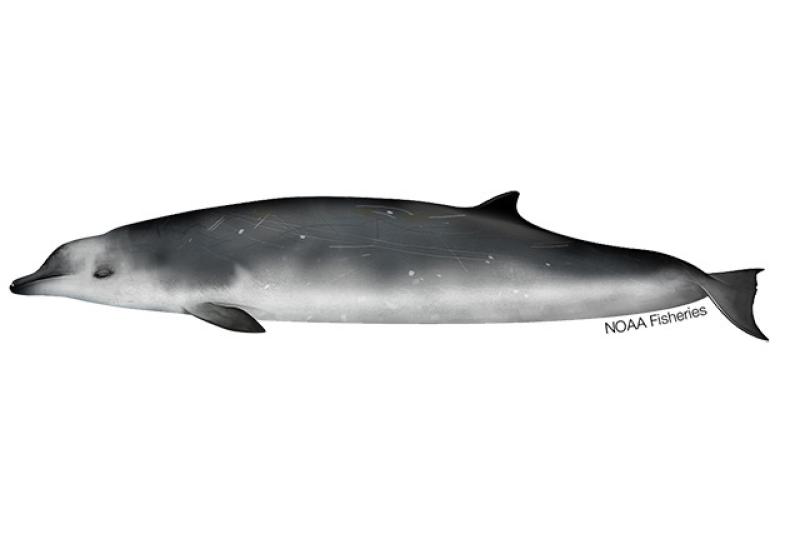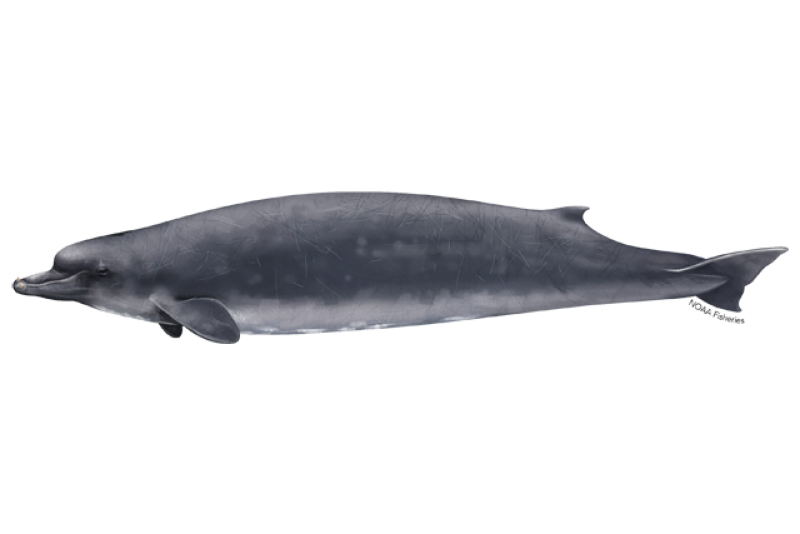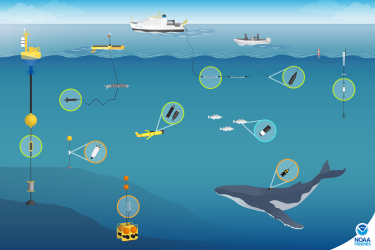Sowerby's Beaked Whale
Mesoplodon bidens
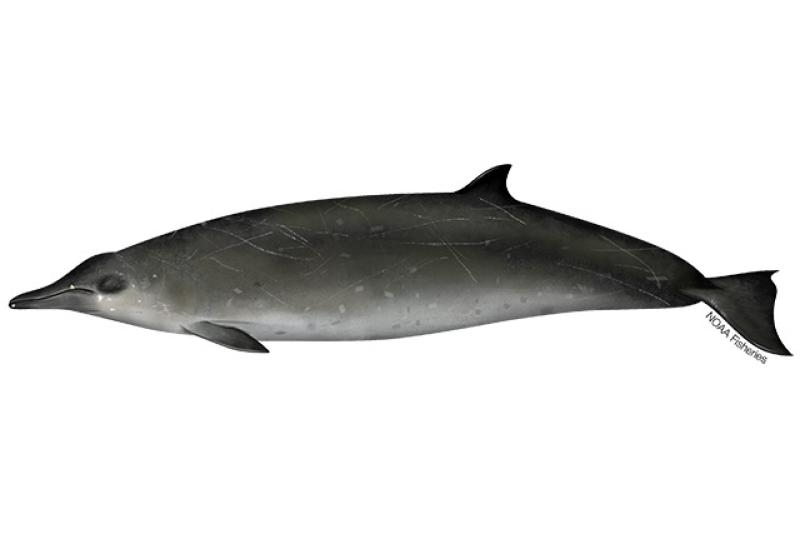
Protected Status
Quick Facts
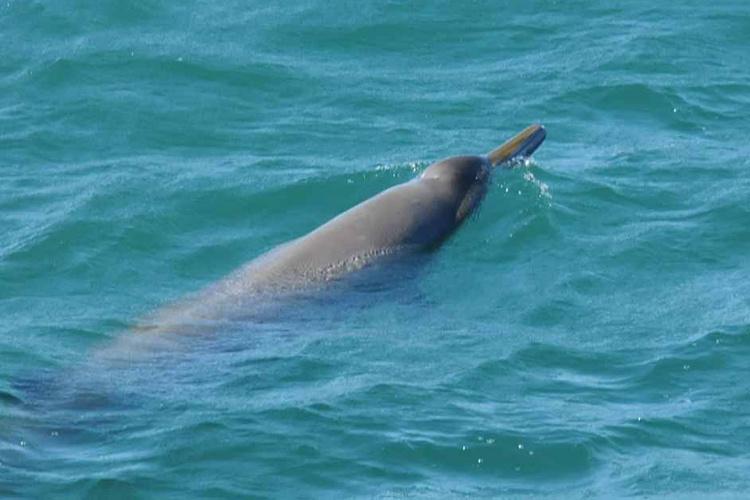 Sowerby's beaked whale. Credit: NOAA Fisheries
Sowerby's beaked whale. Credit: NOAA Fisheries
Sowerby's beaked whale. Credit: NOAA Fisheries
About the Species
 Sowerby's beaked whale. Credit: NOAA Fisheries
Sowerby's beaked whale. Credit: NOAA Fisheries
Sowerby's beaked whale. Credit: NOAA Fisheries
Sowerby's beaked whales, sometimes known as the "North Atlantic beaked whale," are little known members of the beaked whale family, Ziphiidae. The first beaked whale to be discovered, this species prefers the deep, cold, temperate and subarctic waters throughout the North Atlantic Ocean, but has also been reported near the ice pack. Their scientific name, bidens, is derived from the Latin words bi for "two" and dens for "teeth" and refers to the pair of visible teeth that erupt from the lower jaw of mature males.
The beaked whale family is cryptic and skittish. Due to the rarity of sightings at sea, there is little information on the abundance of Sowerby’s beaked whales worldwide.
Like all marine mammals, Sowerby’s beaked whales are protected under the Marine Mammal Protection Act. They face threats from entanglement in fishing gear and human-caused noise.
Population Status
NOAA Fisheries estimates population size for Sowerby’s beaked whales in its stock assessment reports. A stock is a group of animals that occupy the same area and interbreed. There is little information on the abundance of this species worldwide. Thus, data are insufficient to estimate population trends.
Appearance
As adults, Sowerby's beaked whales can reach estimated lengths of 14.5 to 21 feet and weigh 2,200 to 2,900 pounds. Males, which are generally larger, can be distinguished from females and juveniles by a pair of visible teeth that erupt from their slightly arched lower jaw. Females and juveniles also have teeth, but they remain hidden beneath the gum tissue, and their jawline is straight.
Sowerby's beaked whales have a small- to medium-sized body with a very long, slender beak relative to other beaked whales, as well as a bulge on the forehead area. The beak often emerges at a steep angle when surfacing. They have a small, wide-based, slightly hooked dorsal fin located about two-thirds down their back. Most of their body is charcoal gray with a pale underside, and calves are generally darker than adults. The lower jaw is usually light gray or white. This species has less visible scarring than most other beaked whale species.
Behavior and Diet
Sowerby's beaked whales are usually found individually or in small, closely associated groups averaging between three and 10 individuals. Regular dives range from 10 to 15 minutes, but dives of at least 28 minutes and reaching depths up to 4,920 feet have been recorded. While diving, they use suction to feed on small, deep-sea fish and cephalopods (e.g., squid) in deep waters. When surfacing, this species often lifts its head up out of the water at a 45-degree angle.
Many species of beaked whales (especially those in the genus Mesoplodon) are very difficult to distinguish from one another (even when dead) because they lack easily discernible or apparent physical characteristics. At sea, they are challenging to observe and identify to the species level because of their cryptic, skittish behavior; low profile; and a small, inconspicuous blow at the water’s surface. Therefore, much of the available characterization for beaked whales is to the genus level only, and there is relatively little information about most individual species.
Where They Live
Sowerby's beaked whales prefer the deep, cold temperate and subarctic waters off the continental shelf edge of the North Atlantic Ocean but have also been reported near the ice pack. They are distributed throughout the North Atlantic Ocean (30° to 71° North), ranging from the Norwegian Sea, Labrador Sea, Iceland, and Baltic Sea to the north, and waters off the northeast United States, Madeira, and the Canaries to the south.
Sowerby’s beaked whales may be more common in the eastern than the western North Atlantic Ocean. However, they rarely occur in the Mediterranean Sea. Strandings have occurred in Florida and Italy, but these areas are considered outside their normal range. Their distribution may vary depending on the movements of oceanographic currents. It is unknown whether they undertake seasonal movements or migrations.
Lifespan & Reproduction
Sowerby's beaked whales may reach sexual maturity at about age 7, and their breeding season may be from late winter to spring. A sexually mature female will give birth to a single newborn calf that is about 8 to 9 feet long and weighs about 375 pounds. The estimated lifespan of this species is unknown.
Threats
Entanglement in Fishing Gear
Sowerby’s beaked whales have become entangled or captured in commercial fishing gear, such as driftnets and gillnets, off the U.S. Atlantic and Canadian coasts.
Ocean Noise
Deep-diving cetaceans like Sowerby's beaked whales rely on sound to feed, communicate, and navigate in the ocean. Sound pollution threatens them by interrupting their normal behavior and driving them away from areas important to their survival.
Scientific Classification
| Kingdom | Animalia | Phylum | Chordata | Class | Mammalia | Order | Cetacea | Family | Ziphiidae | Genus | Mesoplodon | Species | bidens |
|---|
Last updated by NOAA Fisheries on 01/14/2025
What We Do
Conservation & Management
All Sowerby’s beaked whales are protected under the MMPA. We protect this species by:
- Reducing interactions with commercial and recreational fishing gear
- Implementing requirements to reduce serious injuries and mortalities
- Minimizing the effects of vessel disturbance, noise, and other human impacts
- Educating the public about the threats beaked whales face
Science
Our research projects have helped us better understand Sowerby’s beaked whales and the challenges they face. Our work includes:
- Stock assessments
- Acoustic monitoring
- Shipboard surveys
How You Can Help
Keep Your Distance
Be responsible when viewing marine life in the wild. Observe all large whales from a safe distance of at least 100 yards and limit your time spent observing to 30 minutes or less.
Report Marine Life in Distress
Report a sick, injured, entangled, stranded, or dead animal to make sure professional responders and scientists know about it and can take appropriate action. Numerous organizations around the country are trained and ready to respond. Never approach or try to save an injured or entangled animal yourself—it can be dangerous to both the animal and you.
Learn who you should contact when you encounter a stranded or injured marine animal
Report a Violation
Call the NOAA Fisheries Enforcement Hotline at (800) 853-1964 to report a federal marine resource violation. This hotline is available 24 hours a day, 7 days a week for anyone in the United States.
You may also contact your closest NOAA Office of Law Enforcement field office during regular business hours.
Featured News
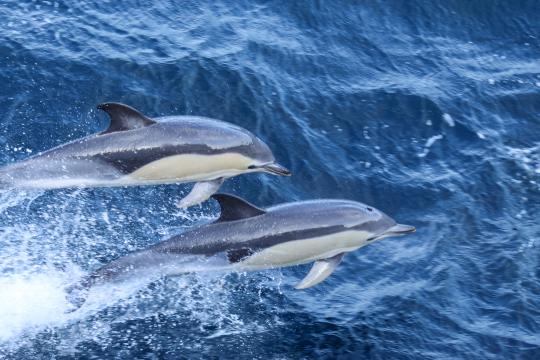 Common dolphins. Credit: NOAA Fisheries/Michelle Klein
Common dolphins. Credit: NOAA Fisheries/Michelle Klein
Celebrating 15 Years of Surveying Protected Species in the Northwest Atlantic

 Rice's Whale. Credit: NOAA Fisheries
Rice's Whale. Credit: NOAA Fisheries
Protecting Species While Planning for Offshore Wind Development in the U.S. Gulf of Mexico
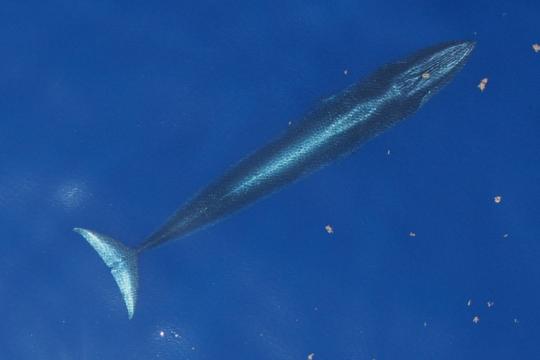 A Rice’s whale just under the surface of the water in the Gulf of Mexico. This endangered whale was recognized as a separate species from the Bryde’s whale in 2021. Credit: NOAA Fisheries under NOAA Permit No. 21938.
A Rice’s whale just under the surface of the water in the Gulf of Mexico. This endangered whale was recognized as a separate species from the Bryde’s whale in 2021. Credit: NOAA Fisheries under NOAA Permit No. 21938.
Celebrate Whale Week with Us: A Message from Janet Coit, Assistant Administrator of NOAA Fisheries
Management Overview
The Sowerby's beaked whale is protected throughout its range under the Marine Mammal Protection Act.
Additionally, the Sowerby's beaked whale is listed under:
- Appendix II of the Convention on International Trade in Endangered Species of Wild Fauna and Flora (CITES)
- Annex II of the Protocol for Specially Protected Areas and Wildlife (SPAW)
Conservation Efforts
Reducing Interactions with Fishing Gear
Sowerby’s beaked whales are caught as bycatch in fishing gear, such as driftnets and gillnets, off the U.S. Atlantic coast. NOAA Fisheries is committed to minimizing bycatch in U.S. fisheries to ensure that fisheries remain sustainable and to protect species such as the Sowerby’s beaked whale.
Learn more about bycatch and fisheries interactions
Overseeing Marine Mammal Health and Stranding Response
We work with volunteer networks in all coastal states to respond to marine mammal strandings including all whales. When stranded animals are found alive, NOAA Fisheries and our partners assess the animal’s health and determine the best course of action. When stranded animals are found dead, our scientists work to understand and investigate the cause of death. Although the cause often remains unknown, scientists can sometimes attribute strandings to disease, harmful algal blooms, vessel strikes, fishing gear entanglements, pollution exposure, and underwater noise. Some strandings can serve as indicators of ocean health, giving insight into larger environmental issues that may also have implications for human health and welfare.
Learn more about the Marine Mammal Health and Stranding Response Program
Marine Mammal Unusual Mortality Events
Sowerby’s beaked whales have been part of a declared unusual mortality event in the past. Under the Marine Mammal Protection Act, an unusual mortality event is defined as "a stranding that is unexpected; involves a significant die-off of any marine mammal population; and demands immediate response." To understand the health of marine mammal populations, scientists study unusual mortality events.
Get information on active and past UMEs
Get an overview of marine mammal UMEs
Addressing Ocean Noise
NOAA Fisheries is investigating all aspects of acoustic communication and hearing in marine animals, as well as the effects of sound on beaked whale behavior and hearing. For example, the use of at least some types of shipboard echosounders decreases the acoustic detection rates of multiple species of beaked whales, indicating that they change their behavior when they hear these echosounders. In 2018, we revised the technical guidance for assessing the effects of anthropogenic sound on marine mammal hearing.
Regulatory History
Sowerby’s beaked whales are protected under the MMPA.
Key Actions and Documents
More Information
Last updated by NOAA Fisheries on 01/14/2025
Science Overview
NOAA Fisheries conducts a variety of research on the biology, behavior, and ecology of Sowerby’s beaked whales. The results of this research are used to inform management decisions and enhance protection efforts for this species.
Stock Assessments
Determining the size of Sowerby’s beaked whale populations helps resource managers gauge the success of NOAA Fisheries’ conservation measures. Our scientists collect and present these data in annual stock assessment reports.
Shipboard Studies
NOAA Fisheries conducts research cruises to collect information on beaked whale stocks, including distribution, habitat preferences, and feeding ecology. These studies also help us estimate the abundance of beaked whales. Information from this research can be used in management actions to protect these animals.
Acoustic Science
Our research is also focused on acoustics—using underwater sound to learn more about species. We study the basic acoustic behavior of cetaceans and fish, mapping the acoustic environment and finding better ways to study cetaceans using passive acoustic technologies. For example, we tow hydrophones behind ships to acoustically detect and locate Sowerby’s beaked whales during surveys. We also use archival bottom-mounted recorders to monitor long-term occurrence of the species at specific recording sites. Our acoustic research also assesses the degree to which human-caused activities are changing the underwater soundscape, how these changes may potentially impact marine animals, and what measures can be taken to mitigate these potential impacts.
More Information
Last updated by NOAA Fisheries on 01/14/2025
Data & Maps
Passive Acoustic Cetacean Map
This mapping tool shows when and where specific whale, dolphin, and other cetacean species were…
Research
Killer Whale and Beaked Whale Posters
Art-Science Collaboration Celebrates the Diversity of Killer Whales and Beaked Whales from Around the World
Passive Acoustics Research Group News & Media
Our Passive Acoustics Research Group frequently makes the news. This page links to articles and other media featuring our staff and their research.
Last updated by NOAA Fisheries on 01/14/2025
